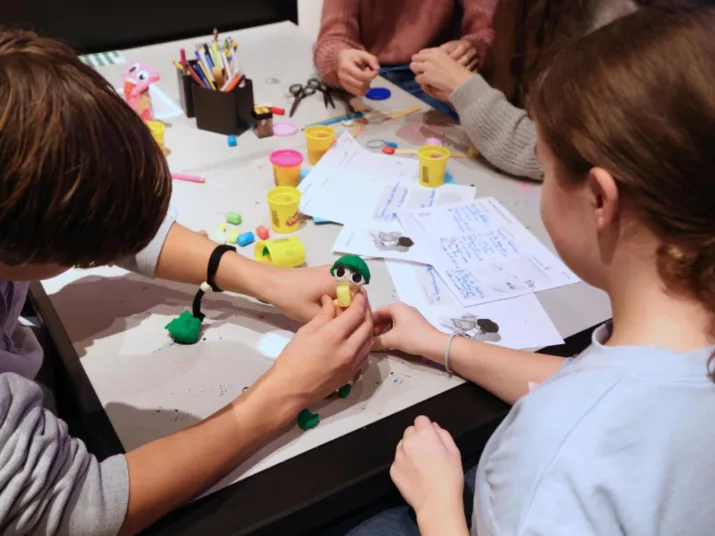
Junge Tüftler*innen
Visiting a workshop at Futurium
Tools of the Future
New technologies will play a significant role in shaping our future. How can we use them to address the challenges of the future? This is something that pupils in Year 4 to 6 can try out for themselves in a three-hour workshop at Futurium. We accompanied a workshop for school classes.

Junge Tüftler*innen
Over the next three hours, 24 pupils from Year 5 will become futurologists. “Do you think there will still be cars 50 years from now?” Felix from the young inventors’ group Junge Tüftler asks right at the beginning. The group splits up, left for “yes” and right for “no”, and the children start discussing: “Yes, cars will still exist, but flying ones!” – “No, we’ll all be riding hoverboards!” – “Fifty years from now, we’ll be able to beam ourselves all over the place; I won’t be needing a car anymore!”
Now that the pupils have been warmed up with questions about the future, things are getting more concrete. The topic of the day is waste management and recycling in the future. The children start by questioning their own behaviour before deciding in small groups which challenge of the future they would like to solve: the ever-growing mountains of electronic waste, plastic in the sea or the waste generated in aircraft. Once they have chosen their problem, they select their tool. What technology do they want to use to meet the challenge – a 3D printer, a drone or maybe they need the help of virtual and augmented reality? What will the tool of the future look like and who will be using it? Creative ideas keep flowing!
Prototype: This 3D printer should make the to-go cup superfluous in the future.
Junge Tüftler
Then it’s time to build the prototypes. With scissors, cardboard, kebab skewers, wool, plasticine, wiggle eyes and glue, the pupils tinker, test and craft their objects. Evelyn, Fiona and Artur are developing VR glasses that turn rubbish collection into a game. If you look through the glasses, the rubbish is displayed as a prize, like in a Jump & Run game, and picking it up earns the players points. Another group is tinkering with a drone that removes rubbish, while yet another team is designing laser goggles that simply pulverise rubbish.
Handmade: When working with the Stopmotion app, the children combine digital and analogue techniques.
Junge Tüftler
Once the prototypes are finished, the teams present their invention and its features. For this purpose, the pupils receive a brief introduction to the Stop Motion Studio app, which they can use to create small stop-motion films on their tablets in no time at all. Stop motion is based on the principle of the flip book. A series of individual images is created with gradual changes in the depicted objects. When viewed in quick succession, the images are perceived as a movement. Now only the final touches remain to be completed, and music and sound effects added, before the video is ready for the big presentation. In the Gallery Walk, the tablets are set up and each team presents their prototype.
After three hours, the workshop is over and the children are bubbling with excitement. “I liked the way we were able to put our own idea into practice,” says twelve-year-old Marcella, touting the benefits of her drone for rubbish-collection. “Next time, we want to build networked drones that can work together to haul away larger pieces of rubbish.” We’re looking forward to the next workshop!